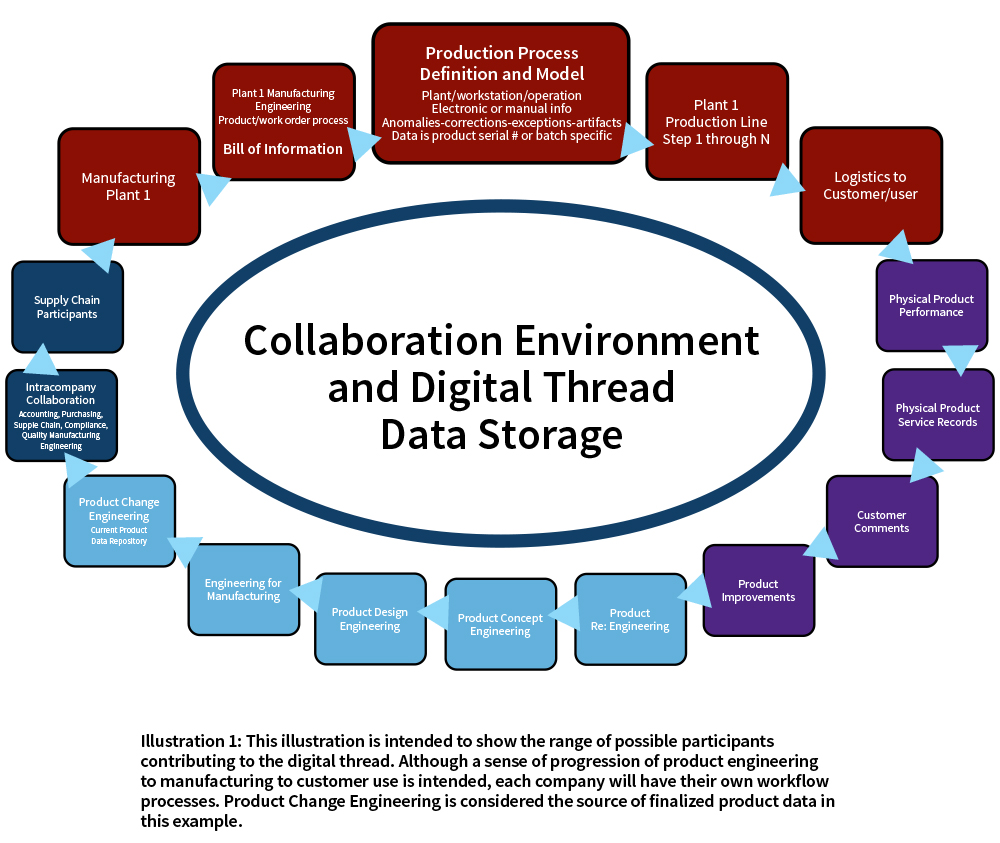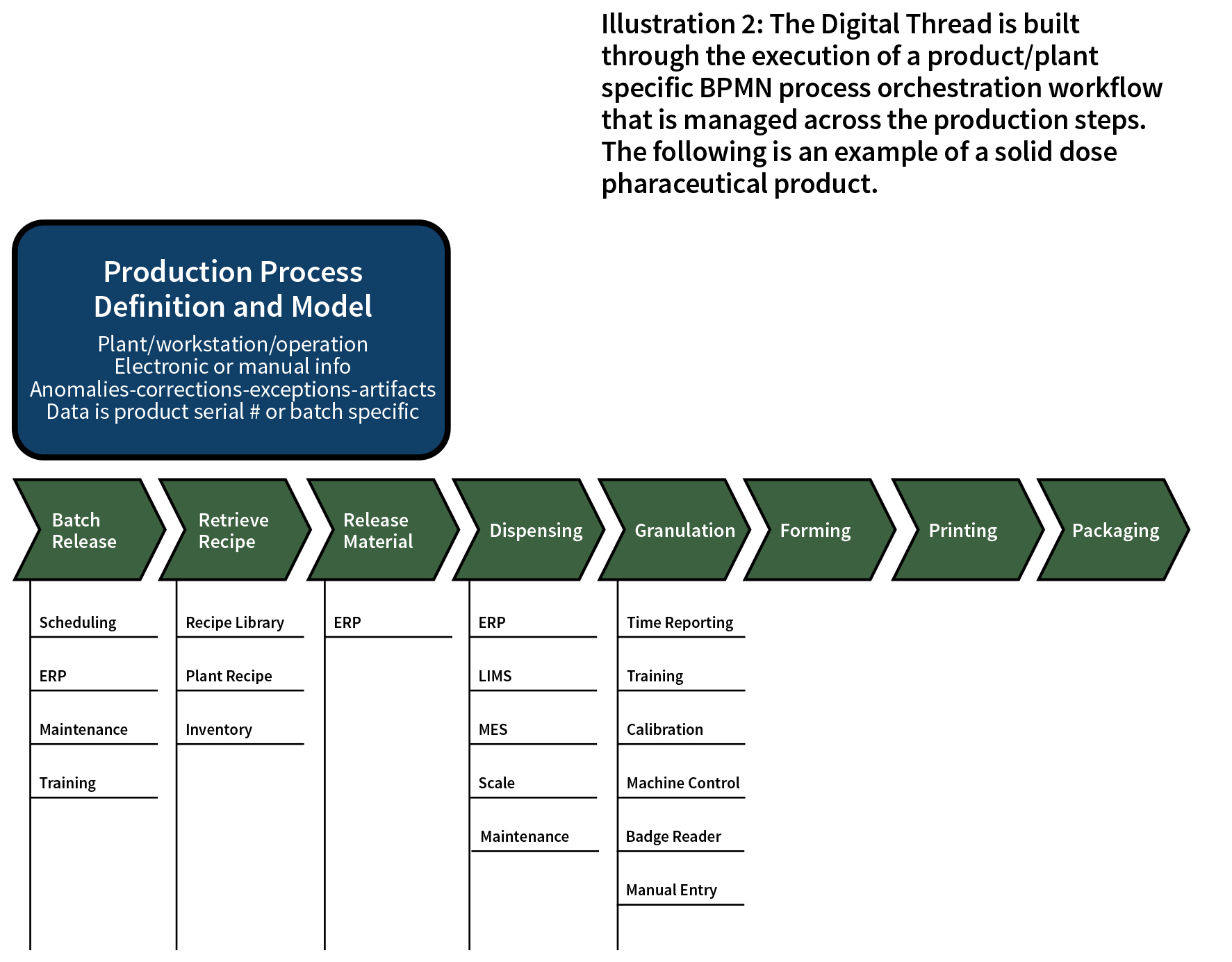
US Department of Defense Definition:
A digital thread is an extensible, configurable, multi-directional integration of authoritative technical data, software, and information throughout a product’s or system’s life cycle, enabling the capture of decision-making information and knowledge.
A concise explanation is that the digital thread contains all the necessary information to build and update digital twins. The digital thread establishes a framework that seamlessly connects business systems across the product lifecycle. The digital thread is created to convert disparate data into actionable information. It can provide data access, integration and transformation capabilities for the digital twin, a vital interface and an integrated global view of all data, models and product information.
What Can Digital Thread
Do For You?
Digital Thread describes the concept of building and maintaining the digital history across the life of the product through engineering design, production/supply chain, and customer use. Our approach to Digital Thread is based on Production Process Management™ (PPM) concepts to deliver and/or retrieve product digital information between all associated and designated information resources including PLM, ERP, value chain partners, MES, scheduling, etc., as defined by you. PPM provides multi-directional information capability that is workstation and workstation operation-centric sup-porting electronic or manual data handling.
Production Process Management™ (PPM) plays a crucial role in forming the core of the Digital Thread by orchestrating the seamless flow of digital information related to a product throughout its entire lifecycle, from design and engineering to manufacturing, and even through service and maintenance. PPM contributes to this by managing and optimizing production processes and ensuring data consis-tency and accuracy across the product’s journey.
Here are a few ways PPM improves your manufacturing processes and forms the Digital Thread:
A. Improved Operational Efficiency: Enables the modeling, automation, and optimization of business processes, leading to streamlined and more efficient operations. This provides a unified view of data and processes across the organization, reducing data silos and redundancy.
B. Enhanced Visibility and Traceability: Ensures that all relevant data and information related to products or processes are connected and accessible in real-time. Provides process visibility, allowing organizations to view and track the progress of tasks and activities at various stages.
C. Future-Proofing: As technologies and market conditions evolve, PPM can be adapted and extended to incorporate new capabilities and data sources. The product-driven process is easily updated to incorporate product or plant environmental evolution such as workstation and production equipment upgrades. Each information resource is treated as a node on your network that can be easily revised.
D. Better Decision-Making: Access to real-time data and analytics within the Digital Thread enables data-driven decision-making and provides tools for process monitoring and reporting, aiding in identifying bottlenecks and areas for improvement.
E. Reduced Errors and Improved Quality: Automation capabilities help reduce manual errors in processes. The process execution ensures that product data is accurate and up-to-date, contributing to better product quality.
F. Faster Time to Market: Accelerate process execution, enabling organizations to bring products and services to market more quickly.
G. Compliance and Governance: Facilitates the enforcement of compliance rules and regulations within processes. Ensures that data and product information adhere to industry standards, regulatory requirements and address the latest product changes.
H. Enhanced Customer Experience: Streamlined processes and quicker response times lead to a better customer experience. Your Digital Thead enables you to provide customers with accurate product information and status updates.
I. Cost Savings: Automation through the Digital Thread reduces manual labor and operational costs by eliminating data redundancies and inefficiencies in processes leading to significant cost savings.
J. Agility and Adaptability: The Digital Thread supports adaptability by providing
a real-time view of product data and processes and allows for agile process design and modification to respond to changing business needs.
K. Collaboration and Communication: Digital Thread platforms include collaboration features, facilitating communication and collaboration among teams and departments. Collaboration is promoted by providing a single source of truth for data and information.
L. Competitive Advantage: Organizations that implement Digital Thread strategies are better positioned to stay competitive in the digital age. They can innovate more rapidly, respond to market changes effectively, and deliver higher-quality products and services.
M. End-to-End Process Integration: Your Digital Thread integrates various stages of the production process, from product design and engineering to manufacturing and beyond. There is a unified platform for managing and optimizing these processes, ensuring that data and information flow smoothly throughout the entire product lifecycle.
N. Data Management and Consistency: The system maintains access to each repository of product-related data, ensuring that information is consistent and
up-to-date. This includes design specifications, bills of materials (BOMs), work instructions, quality control data, and all other operational information you deem necessary and essential for a continuous Digital Thread.
O. Product Lifecycle Management (PLM): Digital Thread is a focal point in delivering PLM product information, allowing organizations to manage the complete lifecycle of a product. This includes capturing design changes, managing revisions, and tracking the history of a product from its initial concept to disposal or recycling.
P. Collaboration and Communication: The systems can facilitate collaboration among various stakeholders, including design teams, engineers, production managers, workstation operators, quality control personnel, and value chain partners. This collaborative environment ensures that everyone can access the latest information and work together efficiently.
Q. Workflow Automation: The system can automate and manage workflows and processes related to production, ensuring that tasks are executed in a structured and efficient manner. This includes automating manufacturing instructions, quality checks, and change management processes.
R. Real-time Monitoring and Control: The Digital Thread can provide real-time visibility into production operations, allowing organizations to monitor progress, track performance against targets, and make timely decisions. This real-time data contributes to the continuous effort to improve performance.
S. Traceability and Compliance: The Digital Thread enables pinpoint traceability of products, materials, and components throughout the supply chain and production process. This traceability is critical for compliance with industry regulations and quality standards.
T. Analytics and Continuous Improvement: These systems often include analytics capabilities to analyze historical data and identify areas for process improvement. This supports the organization’s ability to refine processes and enhance product quality.
U. Scalability and Adaptability: Digital Thread solutions are designed to scale with the organization’s needs and adapt to changes in production processes, making them suitable for both small-scale and large-scale manufacturing operations.
